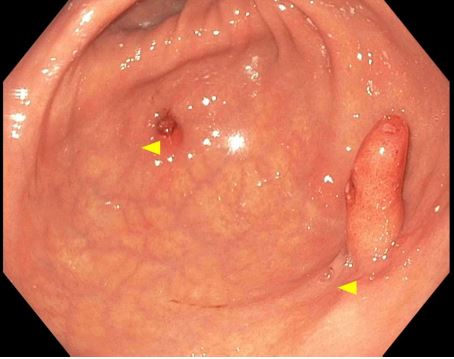Sunday Poster Session
Category: Infections and Microbiome
A Case Series of Urban <i>Helicobacter heilmannii</i> Gastritis
P1342 - A Case Series of Urban Helicobacter heilmannii Gastritis
Sunday, October 26, 2025
3:30 PM - 7:00 PM PDT
Location: Exhibit Hall

Mohamed K. Osman, MD, MPH
NYC Health + Hospitals/Harlem
New York, NY
Presenting Author(s)
Mohamed K.. Osman, MD, MPH1, Thin Phyu Phyu. Aung, MD2, Matthew A. Kalloo, MD3, Alvaro Genao, MD2, Joan A.. Culpepper-Morgan, MD, FACG2
1NYC Health + Hospitals/Harlem, New York, NY; 2NYC Health + Hospitals, New York, NY; 3Harlem Hospital Center, New York, NY
Introduction: Helicobacter heilmanii (aka Gastrospirillium hominis) gastritis is rare, 1.9% in patients with dyspepsia; higher in Asians (3.1%) compared to the West (1.2%). It is linked to domestic animal contact. We present 3 cases of H. heilmannii gastritis in patients with moderate to large hiatal hernia.
Case Description/
Methods: Case 1: 83-year-old Haitian man with BPH, schizophrenia, iron deficiency anemia, new pernicious anemia came with dyspepsia. Hb 11.7, MCV 76.8. EGD showed esophagitis and several large, friable, sessile and pedunculated antral polyps (Figure 1). Pathology: chronic gastritis with no dysplasia. Poly was hyperplastic and H. Heilmannii positive. He received triple therapy (pantoprazole, amoxicillin, and clarithromycin) and improved. EGD 3 months later showed a 5 cm hiatal hernia and gastric erythema. Biopsy: mild chronic gastritis, negative for H. pylori and H. Heilmannii.
Case 2: 81-year-old Hispanic man with dementia and prostate cancer was admitted with left hip fracture. Hb 10, MCV 91.5. EGD to evaluate hematemesis showed a 10 cm hiatal hernia, with no stomach or duodenal lesions. Biopsy showed chronic gastritis with focal intestinal metaplasia, positive for Gastrospirillium hominis by immunostain, and negative for dysplasia. He received triple therapy, improved, and was discharged.
Case 3: 70-year-old Hispanic man with CVA, opioid and alcohol use disorders, was admitted for spinal fracture. Hb 12, MCV 96.6, BUN 50, and creatinine 0.8. EGD done for hematemesis on celecoxib showed a 10 cm hiatal hernia, nodular lower esophagus, and brown fluid in a friable ulcerated hiatal sac. Erosive gastropathy and erythematous duodenopathy was seen. Biopsy showed chronic gastritis with H. Heilmannii with no dysplasia. Both sac and esophageal biopsy revealed mucosal erosions, acute on chronic inflammation and no metaplasia. Celecoxib was stopped. He was started on triple therapy. He died of sepsis 6 days later.
Discussion: Our patients were all men in the 7th and 8th decade with large hiatal hernias and significant CNS disease. All had gross and histologic evidence of gastritis without dysplasia. Two responded to triple therapy. None had recent exposure to domestic animals. All were urban dwellers, but immigrants raising possibility of early exposure to H. Heilmannii. Co-infection with H.pylori was not noted. H. Heilmannii should be considered as cause of gastritis in elderly immigrants.

Figure: Figure 1. Several large, friable, sessile and pedunculated antral polyps
Disclosures:
Mohamed Osman indicated no relevant financial relationships.
Thin Aung indicated no relevant financial relationships.
Matthew Kalloo indicated no relevant financial relationships.
Alvaro Genao indicated no relevant financial relationships.
Joan Culpepper-Morgan indicated no relevant financial relationships.
Mohamed K.. Osman, MD, MPH1, Thin Phyu Phyu. Aung, MD2, Matthew A. Kalloo, MD3, Alvaro Genao, MD2, Joan A.. Culpepper-Morgan, MD, FACG2. P1342 - A Case Series of Urban <i>Helicobacter heilmannii</i> Gastritis, ACG 2025 Annual Scientific Meeting Abstracts. Phoenix, AZ: American College of Gastroenterology.
1NYC Health + Hospitals/Harlem, New York, NY; 2NYC Health + Hospitals, New York, NY; 3Harlem Hospital Center, New York, NY
Introduction: Helicobacter heilmanii (aka Gastrospirillium hominis) gastritis is rare, 1.9% in patients with dyspepsia; higher in Asians (3.1%) compared to the West (1.2%). It is linked to domestic animal contact. We present 3 cases of H. heilmannii gastritis in patients with moderate to large hiatal hernia.
Case Description/
Methods: Case 1: 83-year-old Haitian man with BPH, schizophrenia, iron deficiency anemia, new pernicious anemia came with dyspepsia. Hb 11.7, MCV 76.8. EGD showed esophagitis and several large, friable, sessile and pedunculated antral polyps (Figure 1). Pathology: chronic gastritis with no dysplasia. Poly was hyperplastic and H. Heilmannii positive. He received triple therapy (pantoprazole, amoxicillin, and clarithromycin) and improved. EGD 3 months later showed a 5 cm hiatal hernia and gastric erythema. Biopsy: mild chronic gastritis, negative for H. pylori and H. Heilmannii.
Case 2: 81-year-old Hispanic man with dementia and prostate cancer was admitted with left hip fracture. Hb 10, MCV 91.5. EGD to evaluate hematemesis showed a 10 cm hiatal hernia, with no stomach or duodenal lesions. Biopsy showed chronic gastritis with focal intestinal metaplasia, positive for Gastrospirillium hominis by immunostain, and negative for dysplasia. He received triple therapy, improved, and was discharged.
Case 3: 70-year-old Hispanic man with CVA, opioid and alcohol use disorders, was admitted for spinal fracture. Hb 12, MCV 96.6, BUN 50, and creatinine 0.8. EGD done for hematemesis on celecoxib showed a 10 cm hiatal hernia, nodular lower esophagus, and brown fluid in a friable ulcerated hiatal sac. Erosive gastropathy and erythematous duodenopathy was seen. Biopsy showed chronic gastritis with H. Heilmannii with no dysplasia. Both sac and esophageal biopsy revealed mucosal erosions, acute on chronic inflammation and no metaplasia. Celecoxib was stopped. He was started on triple therapy. He died of sepsis 6 days later.
Discussion: Our patients were all men in the 7th and 8th decade with large hiatal hernias and significant CNS disease. All had gross and histologic evidence of gastritis without dysplasia. Two responded to triple therapy. None had recent exposure to domestic animals. All were urban dwellers, but immigrants raising possibility of early exposure to H. Heilmannii. Co-infection with H.pylori was not noted. H. Heilmannii should be considered as cause of gastritis in elderly immigrants.

Figure: Figure 1. Several large, friable, sessile and pedunculated antral polyps
Disclosures:
Mohamed Osman indicated no relevant financial relationships.
Thin Aung indicated no relevant financial relationships.
Matthew Kalloo indicated no relevant financial relationships.
Alvaro Genao indicated no relevant financial relationships.
Joan Culpepper-Morgan indicated no relevant financial relationships.
Mohamed K.. Osman, MD, MPH1, Thin Phyu Phyu. Aung, MD2, Matthew A. Kalloo, MD3, Alvaro Genao, MD2, Joan A.. Culpepper-Morgan, MD, FACG2. P1342 - A Case Series of Urban <i>Helicobacter heilmannii</i> Gastritis, ACG 2025 Annual Scientific Meeting Abstracts. Phoenix, AZ: American College of Gastroenterology.
